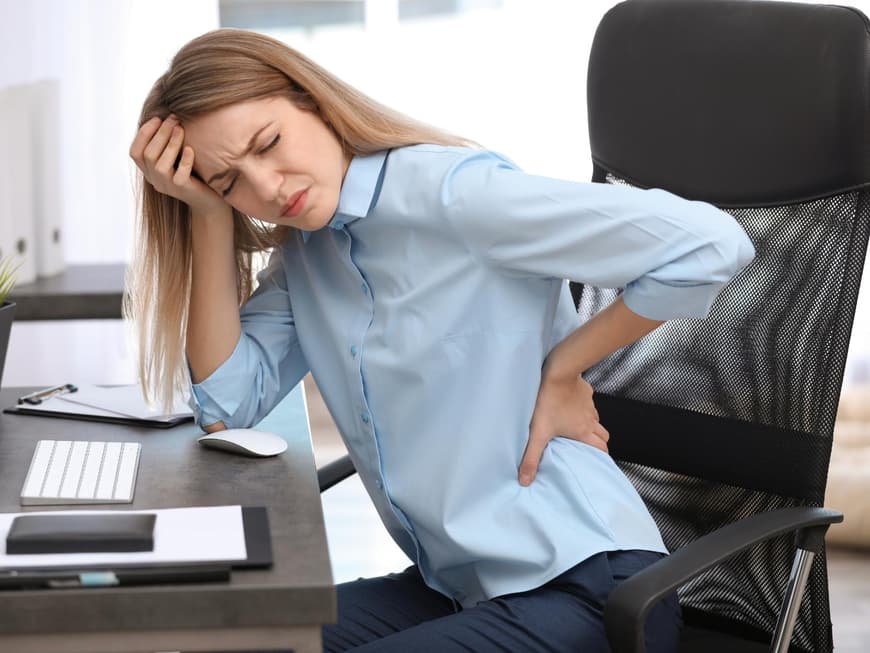
Causes of lower back pain
The causes can be manifold and vary depending on the clinical picture. Back pain often develops over a long period of time. Sometimes it is triggered by physical work or incorrect posture, incorrect strain, tension or short-term overloading of the back. An incorrect movement or a sudden jerk, such as when you trip, can also be to blame. Diseases such as herniated discs or lumbago also trigger pain. SIJ syndrome, a disease of the lower spine and pelvis, can cause pain in the lower back. Triggers for SIJ syndrome include incorrect loading or signs of wear and tear.
A lack of exercise or stress can also cause back pain. The risk of pain also increases with age due to normal signs of wear and tear. Sometimes, however, lower back pain is also due to causes that you would not initially suspect, such as kidney stones, inflammation of the pancreas or endometriosis.
Read also: Middle back pain - causes, symptoms and treatment
What belongs to the lower back?
The lumbar vertebrae are usually affected by lower back pain. This area consists of five individual vertebrae and is directly connected to the coccyx and sacrum. A little further down is the so-called sacroiliac joint. Disorders of this joint can also lead to back pain.
How does back pain manifest itself?
It can vary greatly. For example, sufferers often feel a persistent and dull pain. The pain can also radiate into the legs, for example, which may indicate a slipped disc. In addition, pain also often occurs suddenly, for example after carrying heavy loads or making an incorrect movement.
Preventing lower back pain
It is important that those affected by back pain consult a doctor to get to the bottom of the causes of the pain. The doctor can then make an individual diagnosis or, if necessary, refer the patient to a specialist so that further treatment can be initiated.
Unfortunately, there is no patent remedy for back pain. However, exercise is always a good way of preventing pain. Try to move as much as possible in everyday life, take the stairs instead of the elevator and walk a lot. Back-friendly sports such as swimming, aqua gymnastics, Nordic walking or yoga are also good preventative measures. Many gyms also offer back classes with exercises specifically designed for the back. This allows you to specifically strengthen your lower back muscles. We can also integrate simple back exercises into our everyday lives at home.
It is also important to avoid stress in general, as this also promotes the development of back pain. If you sit in an office all day, you should get up and move around every now and then, for example by taking a walk during your lunch break. A workstation with a height-adjustable desk is also a good option so that you can stand up from time to time.
Lower back pain: What to do?
Here, too, it depends on the diagnosis you have received from your doctor. Is it an acute problem, such as a slipped disc or lumbago, or is the pain caused by tension? In the case of acute lumbago, for example, the doctor can administer a local anesthetic to provide relief. In the case of a slipped disc, patients are often first given painkillers and anti-inflammatory medication to get rid of the acute pain. This is often followed by physiotherapy with exercises designed to relieve pressure on the spine. A visit to an occupational therapist can also provide relief.
Ointments, massages or heat can help relieve tension. Lie down on a warmed grain cushion or apply a heat plaster to the affected area. However, these should not remain on the skin for too long. Here is a well-reviewed heat plaster. A heating pad is also pleasant for pain. Store here for a model with good reviews.
Exercises to relieve pain
The so-called stepped position can provide relief for acute pain. Lie flat on your back with your legs raised and your lower legs at right angles to your thighs. Choose a suitable surface, such as a sofa or chair. The support should be about as high as the length of your thighs.
Rolling up" is also said to help with acute pain. To do this, lie flat on your back and pull your legs up. Then wrap your arms around your legs below your knees and pull them towards your body. Hold the position for about 5 breaths, then put your legs down. Repeat if necessary. The exercise is designed to strengthen our back and gluteal muscles and stretch the muscles.
Note: If you are not sure whether you are performing a back exercise correctly, seek advice from a physiotherapist or physiotherapist. They can give you personal assistance and, if necessary, intervene if you are performing an exercise incorrectly. Incorrectly performed exercises or movements can make the pain even worse. It is also always important to start with simple exercises and to listen to your body's signals.
Which sleeping position is the right one for back pain?
Even though most people prefer to sleep on their side, experts say that it is best to sleep on your back if you have back pain. This is the most back-friendly sleeping position, as our weight is distributed more evenly than when we sleep on our side or stomach. A pillow under your knees or a rolled-up towel can help you to adopt a comfortable position and get used to sleeping on your back.
>> What to do if you have trouble sleeping?
Read also:
People with migraines can no longer hear these sentences
Stimulate circulation: These tips will get you going
Author: Ilka-Marie Hagenbücher
